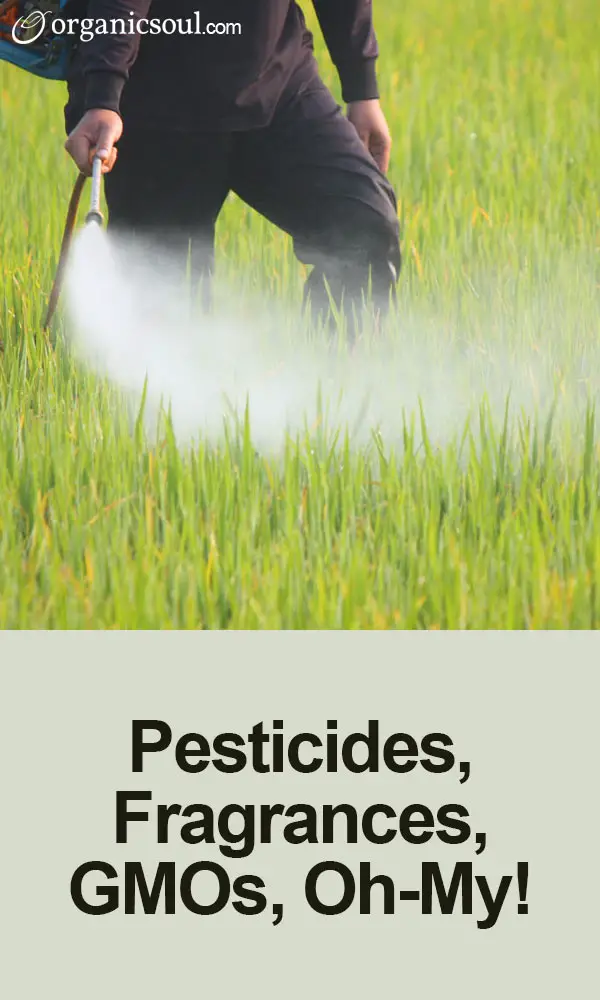
Over the past few months, our food has been getting a lot of attention in the media. Whether it has been about pesticides turning frogs male or Frankenfish, it seems like the science behind our good eats is something out of a horror movie. That said, let’s revisit some of the recent topics for a deeper look into the science behind them.
Like Organic Soul on Facebook
Three such topics are of particular interests: pesticides, fragrances, and genetically modified organisms (GMOs) along with hormones. We won’t linger too much on the basics here; rather, we’ll try to focus on the logic behind why the presence of these three things is dangerous in our diet and lifestyle.
Pesticides
Pesticides are everywhere, and pesticides are dangerous. For a look back at the development of pesticides, along with its common usages, check out Living in a world of Poison: Pesticides and Your Health. Essentially, pesticides – which includes herbicides and insecticides among others – are harsh chemicals that aim at killing off or controlling some types of “pest”, which may be anything from a weed to a rodent.
Whenever a pesticide is introduced, the company must first test it. Most often, this is on rats. If the rats do not die or develop cancer in a short amount of time, then the EPA usually registers the new toxin and it soon reaches our lawns.
Let’s take methyl iodide, abbreviated as “Mel”, for example. Despite this chemical being so toxic it is actually used to induce cancer in laboratory experiments, the EPA has granted its registration as a fumigant. Mel has been prompted to be used as an herbicide, fungicide, nematicide, and even a fire extinguisher. It also has replaced bromomethane as a soil disinfectant, which was banned under the Montreal Protocol.
Mel, like so many other pesticides, is incredibly toxic. Around 20-30 percent of the population is already sensitive to pesticides, and with new powerful chemicals like Mel being introduced, the effect will be a “significant adverse impact on public health”, according to external science panel for Mel. Over 50 scientists, five of which are Nobel laureates, petitioned against Mel’s usage and called it “one of the more toxic chemicals” that would be used today.
Mel, like any highly toxic pesticide, basically works the same way as nerve gas. Acute exposure to these chemicals can kill you, but more often causes illness or irritation and prevents you from thinking clearly. Chronic exposure can lead to neurological damage like Parkinson’s and Alzheimer’s and increases the chance for reproductive and endocrine system disorders.
Fragrances
Fragrances can be just as bad. Originally developed to mask peoples scent because we didn’t takes baths everyday, fragrances are now chemically designed to smell like the flowers we all love and are now used at our private discretion. Interestingly, the government doesn’t regulate the use of chemicals in fragrances.
The basic idea here is that what does on your skin, goes through it. Fragrances are the most common volatile organic compounds (VOCs) we come into contact with, and they have a huge correlation to develop auto-immune disorders. Specifically, they correlate to asthma, lupus, and scleroderma. The main reason behind their potential danger is simply because people are naturally averse to the chemicals used; the body is essentially allergic.
Without a doubt, these vastly underestimated chemicals can have major impacts on our lives. In fact, the 20 most common chemicals found in 31 fragrances all have been found to increase things like depression, kidney damage, fatigue, ataxia (loss of muscle coordination), and asthma. With the continued introduction of new fragrances, many of these diseases or disorders have all skyrocketed. Asthma, for example, has increased over 30 percent in the last 10 years.
GMOs And Hormones
A great majority of people have surely heard of the new Frankenfish, a poster child for GMO fear and speculation. On the heels of this development, a new court order with Monsanto concerning sugar-beets has ruled that more peer-reviewed researched must be done before allowing the planting of these artificial crops.
With GMOs, the danger is in our bodies recognizing what we are eating. Take a McDonalds burger, for example. It looks like a burger, smells like a burger, but isn’t a burger at all. The bun itself has dozens of ingredients, all of which are unhealthy and artificial. The enriched bleached flour, which came from a GMO plant, has little to none nutritional value. To our body, which has evolved for millions of years to digest specific foods, this cardboard like substances isn't deemed useful, and only the fat and sugars are stored. This leads to obesity, diabetes, and has been correlated with the growth of autism.
Likewise, the 100 percent beef sticker, which only means that it is from a cow (tongue, lips, and vagina all count as beef!), is aimed at consumer deception. The beef used in most fast food joints and grocery stores for that matter are injected with vast amounts of hormones and supplements. While there is no cut and dry, cause and effect relationship with GMOs or growth hormones, there is plenty of correlation.
Bart Staes, a spokesman for a group of European environmental and political parties that oppose hormone use said it best, “Where there is doubt, there must be a total ban to protect consumers.”
For more information about GMOs, check out the Organic Soul article Disease on the Dinner Plate?: How GMOs are Affecting our Health.
Solution?
By far, the best defense against the new evils is avoiding them at all costs. Try natural pesticides for your garden, natural fragrances for aromatherapy around the home and for your personal use, and shop for organic, non-GMO products. Having your own organic garden will help too. Good luck and stay healthy!













